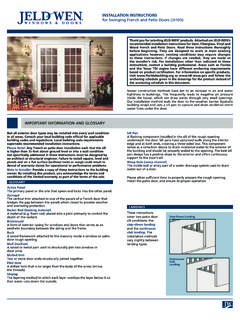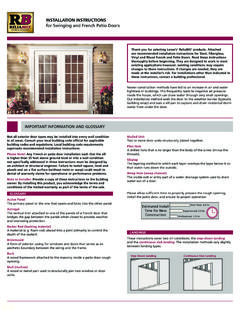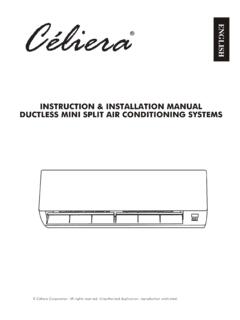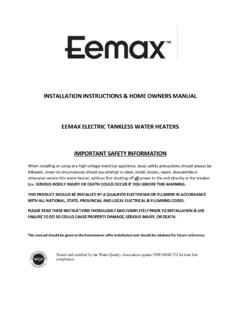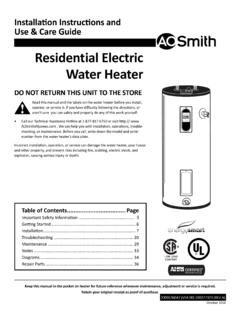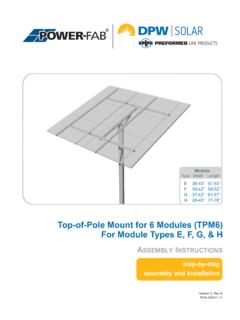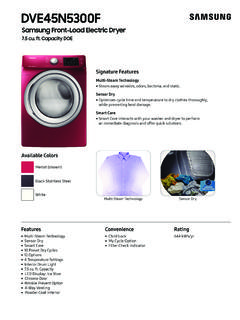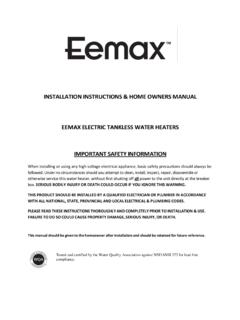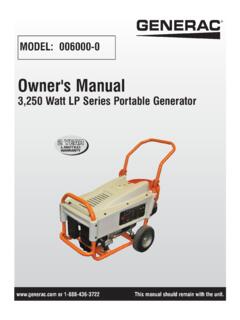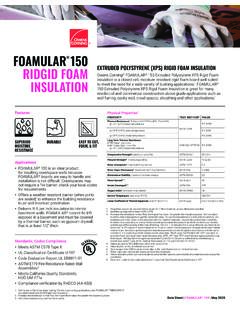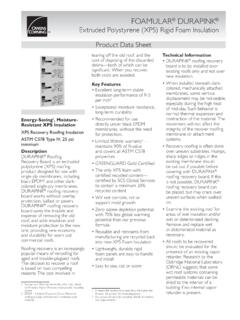Transcription of Extruded Polystyrene (XPS) Rigid Foam Insulation Product ...
1 FOAMULAR 250. Extruded Polystyrene (XPS) Rigid Foam Insulation Product data sheet after exposure to moisture and Product type freeze/thaw cycling. Minimum compressive strength Key Features of 25 psi Excellent long-term stable Wide selection of sizes and insulating performance at R-51 thicknesses per inch Available in straight, tongue and Exceptional moisture groove, or scored square edge resistance, long-term durability Compliant with building codes 2. Limited lifetime warranty and standards Energy-Saving, Moisture maintains 90% of R-value Resistant XPS Insulation and covers all ASTM C 578 Product Applications ASTM C 578 Type IV, 25 psi properties High-performance FOAMULAR.
2 Minimum 250 XPS Insulation : The only XPS foam to be Description GREENGUARD Children Retards the transmission of Owens Corning FOAMULAR & Schools CertifiedSM water vapor and moisture in 250 Extruded Polystyrene masonry walls (XPS) Insulation is a closed cell, The only XPS foam with moisture-resistant Rigid foam certified recycled content Provides continuous Insulation board well suited to meet the certified by Scientific over steel stud framing, in needs for a wide variety of building Certification Systems (SCS) insulated concrete sandwich applications. FOAMULAR to contain a minimum 20% panel walls, in masonry unit 250 XPS Insulation is ideal for recycled content cavity walls, or when used many residential and commercial with non-penetrating, surface Will not corrode, rot or mounted furring systems over construction applications such support mold growth as wall furring, perimeter/ masonry or concrete walls foundation, cavity wall, pre-cast Zero ozone depletion potential Insulates and retains its concrete, under slab, crawl spaces.
3 With 70% less global warming properties in below grade sheathing and other potential than our previous perimeter and foundation FOAMULAR 250 XPS Insulation formula applications, or directly is classified as a Type IV Product beneath the concrete slab to when tested in accordance with Reusable complement the insulating ASTM C 578 and provides a long- Lightweight, durable Rigid sheathing envelope around the term thermal performance of R-5 foam panels are easy to handle building framing per inch. and install FOAMULAR 250 XPS. Like all FOAMULAR Easy to saw, cut or score Insulation is ideal for below XPS Insulation products, grade applications.
4 Extruded FOAMULAR 250 XPS Versatile applications: sheathing, Polystyrene (XPS) Insulation is Insulation is made with Owens foundation walls, masonry resistant to degradation from Corning's patented Hydrovac cavity walls3 the components of common process technology under soils and will retain its insulating strict quality control measures, Not for use in roofing. For performance characteristics which makes it highly resistant roofing applications, use even after prolonged exposure to moisture and permits the FOAMULAR THERMAPINK . to moisture Product to retain it's high Extruded Polystyrene R-value year after year even Insulation . FOAMULAR 250.
5 Extruded Polystyrene (XPS) Rigid Foam Insulation Product data sheet Provides a weather resistant Typical Physical Properties1. barrier (when joints are sealed) FOAMULAR 250 Extruded Polystyrene Insulation to enhance the building's Property Test Method2 Value resistance to air and moisture Thermal Resistance3, R-Value (180 day) minimum, hr ft 2 F/Btu (RSI, C m2 /W). penetration @ 75 F (24 C) mean temperature ASTM C 518. " Thickness ( ). 1" Thickness ( ). Technical Information 1 " Thickness ( This Product is combustible. A 2" Thickness 10 ( ). 2 " Thickness ( ). protective barrier or thermal 3" Thickness 15 ( ). barrier is required as specified 4" Thickness 20 ( ).)
6 @ 40 F ( C) mean temperature in the appropriate building " Thickness ( ). code. For additional information, 1" Thickness ( ). consult MSDS or contact Owens 1 " Thickness ( ). 2" Thickness ( ). Corning World Headquarters at 2 " Thickness ( ). 1-800-GET-PINK . 3" Thickness ( ). 4" Thickness ( ). Long Term Thermal Resistance, LTTR-Value3, minimum All construction should be hr ft 2 F/Btu (RSI, C m2 /W). evaluated for the necessity to @ 75 F (24 C) mean temperature CAN/ULC S770-03. " Thickness N/A. provide vapor retarders. See 1" Thickness ( ). current ASHRAE Handbook of 1 " Thickness ( ). 2" Thickness ( ). Fundamentals. 2 " Thickness ( ).
7 3" Thickness ( ). FOAMULAR 250 XPS Insulation 4" Thickness ( ). is a non-structural material and Compressive Strength4, minimum psi (kPa) ASTM D 1621 25 (172). Flexural Strength5, minimum psi (kPa) ASTM C 203 75 (517). must be installed on framing Water Absorption 6, maximum % by volume ASTM C 272 which is independently braced Water Vapor Permeance7, maximum perm (ng/Pa s m2) ASTM E 96 (86). and structurally adequate to meet Dimensional Stability, maximum % linear change ASTM D 2126 required construction and service Flame Spread 8, 9 ASTM E 84 5. Smoke Developed 8, 9, 10 ASTM E 84 45-175. loading conditions. Oxygen Index8, minimum % by volume ASTM D 2863 24.
8 Service Temperature, maximum F ( C) 165 (74). FOAMULAR Insulation can be Linear Coefficient of Thermal Expansion, in/in/ F (m/m C) ASTM E 228 x 10 -5 ( x 10 -5). exposed to the exterior during 1. Properties shown are representative values for 1" thick material, unless otherwise specified. normal construction cycles. 2. Modified as required to meet ASTM C 578. 3. R means the resistance to heat flow; the higher the value, the greater the Insulation power. This Insulation must be During that time some fading installed properly to get the marked R-value. Follow the manufacturer's instructions carefully. If a manufacturer's of color may begin due to UV fact sheet is not provided with the material shipment, request this and review it carefully.
9 R-values vary depending on many factors including the mean temperature at which the test is conducted, and the age of the sample at exposure, and, if exposed for the time of testing. Because Rigid foam plastic Insulation products are not all aged in accordance with the same standards, it is useful to publish comparison R-value data . The R-value for FOAMULAR XPS Insulation is provided extended periods of time, some from testing at two mean temperatures, 40 F and 75 F, and from two aging (conditioning) techniques, 180 day real- degradation or dusting of the time aged (as mandated by ASTM C 578) and a method of accelerated aging sometimes called Long Term Thermal Resistance (LTTR) per CAN/ULC S770-03.
10 The R-value at 180 day real-time age and 75 F mean temperature is Polystyrene surface may begin. It commonly used to compare products and is the value printed on the Product . is best if the Product is covered 4. Values at yield or 10% deflection, whichever occurs first. 5. Value at yield or 5%, whichever occurs first. within 60 days to minimize 6. data ranges from to value shown due to the level of precision of the test method. 7. Water vapor permeance decreases as thickness increases. degradation. Once covered, the 8. These laboratory tests are not intended to describe the hazards presented by this material under actual fire conditions.
